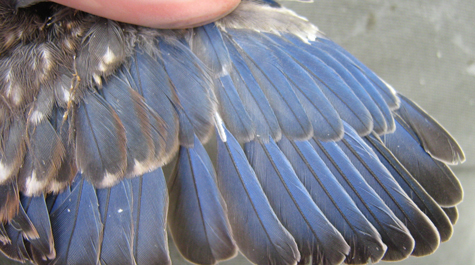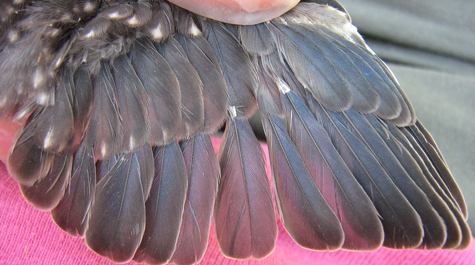Off to med school...and he's already published
Andrew Bouland ’12 will enter medical school in a few weeks with a published scientific paper under his belt.
Several of his med school classmates at the University of Maryland will no doubt be able to say the same thing, but Bouland’s paper is in the world’s premier ornithology journal—and he’s the first author. Plus, the research is groundbreaking.
“This is the first demonstration in any species of wildlife that mercury affects sex ratio of offspring,” said Dan Cristol, professor of biology at William & Mary. Cristol is one of the co-authors on Bouland’s paper, which documents a trend among birds in a mercury-contaminated habitat to have more female offspring.
The paper, published in the Journal of Avian Biology, is the culmination of research that began in 2005 in Virginia’s South River. Cristol and his students examined the effects of mercury on three species of birds—kingfishers, bluebirds and tree swallows—living in an area of the Shenandoah Valley that suffered industrial mercury pollution in the 1930s and 1940s.
The paper, titled “Female-biased offspring sex ratios in birds at a mercury-contaminated river,” shows that all three species were producing females at a higher rate than expected. Bouland explained that the three species were selected based on their feeding habits. Kingfishers, which eat fish directly from the river, showed the highest levels of mercury. Bluebirds, which have a diet of terrestrial insects, showed the least. Tree swallows, eating essentially 50 percent aquatic insects and 50 percent terrestrial, were intermediate in terms of mercury levels in their blood.
Bouland points out that even though each species of bird had different levels of mercury contamination, all three species produced more female offspring than expected.
“Species didn’t have an effect on how skewed nestling ratios were in terms of production of females. That’s an interesting finding in itself,” he said.
There are two hypotheses to explain the mechanism that makes mercury-contaminated birds tend to have daughters at a higher rate. The first, Bouland explained, is that mercury could somehow disrupt the dispersal of androgens, hormones generally associated with development of male offspring.
The second hypothesis, he said, is that mostly female clutches could be an adaptive, evolutionary response by the mothers weakened by mercury. Either way, an overabundance of daughters is bad news for birds.
“The implication for this is in terms of effective population sizes of these birds. You’re going to see more females than males,” he said. “This is a problem because these birds are mostly monogamous. So when you have more females than males, that poses a problem for the population.”
The researchers in the field, which included co-authors Ariel White, Kevin Lonabaugh and Claire Varian-Ramos, collected blood from nestlings and mothers. Bouland noted that mothers were sampled because unlike humans, the female is the heterogametic gender in birds, controlling the sex of the offspring.
The researchers were able to easily sex the kingfishers and bluebirds in the field, using feather color to distinguish male from female. Young tree swallows are impossible to sex by sight, so Bouland determined the genders in the lab, using the polymerase chain reaction to examine the sex chromosomes of the samples.
The findings are important for studies of wildlife in contaminated areas, but also have immediate human implications, Cristol said.
“For one thing, this shows that it’s important to understand other species to try to predict environmental threats to humans better,” he said. “Interestingly, this skewed ratio toward female offspring has already been shown to be the case in humans exposed to mercury.”
Bouland explained that human births in Japan among the population affected by the enormous Minamata Bay methylmercury contamination showed a similar skewing toward females. There have also been several studies of Arctic villages in which very few boys have been born recently. Cristol points out that humans who ingest mercury through eating wildlife, such as the indigenous people in the Arctic, are also exposed to many other chemicals, “so it’s not as clear a case as with our birds.”
 Skip to main content
Skip to main content




